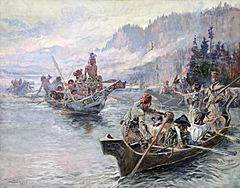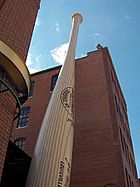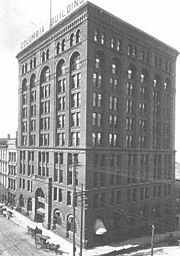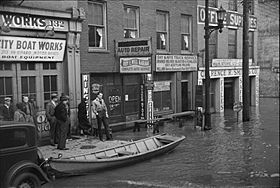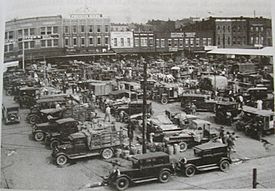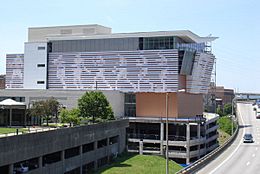History of Louisville, Kentucky facts for kids
The Ohio River, with only one set of rapids in the middle of its long journey, made it a perfect spot for a town to grow. Louisville, Kentucky, was founded in the late 1700s. Starting as a frontier settlement, it quickly became a major trading hub in the mid-1800s and an important industrial city in the early 1900s. After a decline in the mid-20th century, it bounced back in the late 1900s as a lively American city known for its culture.
The history of Louisville, Kentucky covers more than two centuries, starting in the late 1700s. Before Europeans arrived, the area was mostly empty due to conflicts like the Beaver Wars in the 1600s. No Native American groups lived there permanently, but the land was used for hunting by the Shawnee from the north and the Cherokee from the south. The city's geography and its spot on the Ohio River made it attractive to people from very early times. Louisville is located at the Falls of the Ohio River, which were once part of Kentucky County, Virginia. These rapids made river travel difficult, so settlements grew where boats had to unload their goods and carry them around the falls. The first European settlements were made during the American Revolutionary War by soldiers from Virginia, led by George Rogers Clark. They first settled on Corn Island in 1778, then built Fort-on-Shore and Fort Nelson on the mainland. The town was officially recognized in 1780 and named Louisville to honor King Louis XVI of France. That year, 301 new settlers arrived.
In 2003, the city of Louisville joined with Jefferson County to form Louisville-Jefferson Metro. As of the 2010 census, it is the largest city in Kentucky, the second largest on the Ohio River, and the 29th largest city in the United States.
Many famous people have lived in Louisville. These include inventor Thomas Edison, Supreme Court Justice Louis Brandeis, boxing legend Muhammad Ali, newscaster Diane Sawyer, and actors Jennifer Lawrence and Tom Cruise.
Louisville has also been the site of important events. In 1883, it hosted the largest exhibition of its time, which was the first big space lit by Edison's light bulbs. It also had the first library in the South that was open to African Americans. In medicine, the first human hand transplant in the United States happened here in 1999, and the first self-contained artificial heart transplant took place in 2001.
Contents
Early History Before European Settlement (Before 1778)
People lived in the Louisville area for a long time, from at least 1,000 BCE until about 1650 CE. Then, the Beaver Wars caused many people to leave the region. Archaeologists have found several ancient sites in Jefferson County's wetlands. One important discovery was at McNeeley Lake Cave, and many others were found near the Louisville International Airport.
People from the Adena culture and later the Hopewell tradition lived here, with hunting villages along Mill Creek and a large village near what is now Zorn Avenue, overlooking the Ohio River. Archaeologists have found 30 sites in Jefferson County linked to the Fort Ancient and Mississippian cultures, which were active from 1,000 AD until about 1650. The Louisville area was on the eastern edge of the Mississippian culture, where leaders built villages and cities with large earthwork mounds.
When European explorers and settlers began entering Kentucky in the mid-1700s, there were no permanent Native American settlements in the region. The land was used as hunting grounds by the Shawnee from the north and the Cherokee from the south.
The story of the first European to visit the area, the French explorer René-Robert Cavelier, Sieur de La Salle in 1669, is not fully proven. La Salle traveled along the St. Lawrence River to Lake Ontario and Lake Erie. Reports of what happened next are different, and it's not clear if he reached the Ohio River. He did not claim to discover the Ohio River or travel to the falls on that trip. Later, he explored parts of the Mississippi River and Ohio river valleys, claiming much of this land for France.
In 1751, the English colonist Christopher Gist explored areas along the Ohio River. After losing the French and Indian War (part of the Seven Years' War in Europe), France gave control of Kentucky to Britain.
In 1769, colonist Daniel Boone created a trail from North Carolina to Tennessee. He spent the next two years exploring Kentucky. In 1773, Captain Thomas Bullitt led the first group to explore Jefferson County. They surveyed land for Virginians who had received land grants for their service in the French and Indian War. In 1774, James Harrod began building Fort Harrod in Kentucky. However, battles with Native American tribes forced these new settlers to leave. They returned the next year, as Daniel Boone built the Wilderness Road and established Fort Boonesborough. In 1776, the colony of Virginia declared the Transylvania Land Company illegal and created Kentucky County in Virginia from that land.
Founding and Early Growth (1778–1803)
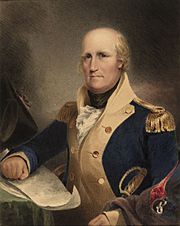
Colonel George Rogers Clark established the first Anglo-American settlement near modern-day Louisville in 1778, during the American Revolutionary War. He was leading a military campaign against the British in areas north of the Ohio River, called the Illinois Country. Clark gathered 150 soldiers, known as the Illinois Regiment, and 80 civilians who wanted to settle in Kentucky. They arrived at the Falls of the Ohio on May 27. Clark thought it was a perfect spot for a communication post. The settlers helped Clark hide the real reason for his presence.
The soldiers helped the civilians build a settlement on what became Corn Island. They cleared land and built cabins. On June 24, Clark left with his soldiers to start their military campaign. A year later, at Clark's request, the settlers moved across the river and created the first permanent settlement. By April, they called it "Louisville" to honor King Louis XVI of France, whose government helped the colonists in the Revolutionary War. Today, George Rogers Clark is known as the European-American founder of Louisville, and many places are named after him.
In its early days, Louisville and the surrounding areas faced attacks from Native Americans who wanted to push out the settlers. Since the Revolutionary War was still happening, all early residents lived inside forts, as suggested by the government of Kentucky County, Virginia. The first fort, at the northern tip of today's 12th street, was called Fort-on-Shore. To protect against British attacks, a larger fort called Fort Nelson was built north of Main Street between Seventh and Eighth streets, covering almost an acre. This fort was considered the strongest in the west after Fort Pitt. After the Revolutionary War, the need for strong forts decreased, and Fort Nelson began to decline.
In 1780, the Virginia General Assembly and then-Governor Thomas Jefferson approved Louisville's town charter on May 1. Clark recruited early Kentucky pioneer James John Floyd, who helped plan the town. Jefferson County, named after Thomas Jefferson, was formed at this time as one of Kentucky's first counties. Louisville became the county seat.
Also in 1780, three hundred families moved to the area. Louisville's first fire department was started, and William Pope laid out the first street plan. Daniel Brodhead opened Louisville's first general store in 1783. He was the first to move out of Louisville's early forts. James John Floyd became the first Judge in 1783 but was killed later that year. The first courthouse, a 16 by 20-foot (6.1 m) log cabin, was finished in 1784. By this time, Louisville had 63 finished houses, 37 partly finished, 22 unfinished, and over 100 log cabins. Shippingport, founded in 1785, was important for early Louisville, allowing goods to be moved around the Falls of the Ohio. The first church was built in 1790, the first hotel in 1793, and the first post office in 1795. In the 1780s and early 1790s, Louisville was not growing as fast as Lexington in central Kentucky. This was due to Native American attacks (which ended in 1794 after the Battle of Fallen Timbers), a land ownership dispute, and Spanish rules limiting trade down the Mississippi River to New Orleans. By 1800, Louisville's population was 359, compared to Lexington's 1,759.
From 1784 to 1792, meetings were held to discuss Kentucky separating from Virginia. On June 1, 1792, Kentucky became the fifteenth state in the United States, and Isaac Shelby became its first Governor.
In 1803, Meriwether Lewis and William Clark prepared for their famous expedition across North America at the Falls of the Ohio in Louisville. The Lewis and Clark Expedition would take them across the western U.S., exploring the Louisiana Purchase, and eventually to the Pacific Ocean.
City Growth (1803–1900)
Before the Civil War
Before steamboats, all people and goods arrived by flatboats and keelboats, which could not easily travel upstream. This made it very expensive to send goods upriver. Also, Spain closed the Mississippi River below Vicksburg, Mississippi to American ships in 1784, meaning there was little market for goods produced in early Louisville. This improved with Pinckney's Treaty, which opened the river and made New Orleans a free trade zone by 1798.
However, most cargo was still sent downstream in the early 1800s. Boats passing through the falls still had to unload all their cargo, which helped local businesses. As the frontier days ended, log houses and forts disappeared. Louisville saw its first newspaper, the Louisville Gazette, in 1807, its first theater in 1808, and its first dedicated church building in 1809. The city's population grew by 400% by 1810.
The way goods were shipped was about to change with the arrival of steamboats. The first steamboat, the New Orleans, arrived in 1811, traveling downstream from Pittsburgh. Many thought steamboats could not travel back upriver against the current. However, in 1815, the Enterprise, captained by Henry Miller Shreve, became the first steamboat to travel from New Orleans to Louisville. This showed that steamboats could make upriver travel and shipping practical, changing trade forever.
Industry and manufacturing came to Louisville and nearby areas like Shippingport. Some steamboats were built in Louisville, and many early mills and factories opened. Other towns also grew at the falls: New Albany, Indiana in 1813 and Portland in 1814. Each competed with Louisville to be the main settlement. Still, Louisville's population grew quickly, tripling from 1810 to 1820. By 1830, it became Kentucky's largest city and later added Portland and Shippingport.
In 1816, the Louisville Library Company, the city's first library, opened. Also, over many years, the University of Louisville was founded from earlier schools like the Jefferson Seminary.
To help boats get around the falls, the Louisville and Portland Canal was finished in 1830. Because of epidemics and the need to treat sick or injured river workers, Louisville Marine Hospital was completed in 1825. Today, this area is Louisville's Medical Center.
In 1828, Louisville's population passed 7,000, and it became Kentucky's first city. John Bucklin was elected the first Mayor. City status gave Louisville some legal power and the ability to collect more taxes, which led to the state's first public school in 1829.
In 1831, Catherine Spalding moved to Louisville and started Presentation Academy, a Catholic school for girls. She also founded the St. Vincent Orphanage, later called St. Joseph Orphanage.
Louisville's famous Galt House hotel was built in 1834. In 1839, a race similar to the modern Kentucky Derby was held at Old Louisville's Oakland Race Course. Over 10,000 people watched Grey Eagle lose to Wagner. This race happened 36 years before the first Kentucky Derby. Louisville became a center for selling horses and other livestock from Kentucky's Bluegrass Region, where horse breeding was a big part of the economy.
The Kentucky School for the Blind was founded in 1839, making it the third-oldest school for the blind in the country. In 1847, William H. Gibson opened one of the city's first schools for African Americans in a church basement.
In 1848, Zachary Taylor, a hero of the Mexican–American War who lived in Jefferson County, was elected the 12th President of the United States. He served only sixteen months before he died in 1850 and was buried in Louisville.
After the 1850 Census, Louisville was the nation's tenth largest city, and Kentucky was the eighth most populated state.
The Louisville and Nashville Railroad (L&N) Company was founded in 1850 by James Guthrie. When the railroad was finished in 1859, Louisville's location at the Falls of the Ohio became even more important for rail and water transportation.
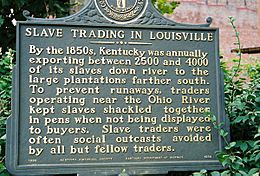
On August 6, 1855, a day called Bloody Monday, riots broke out during an election. Mobs from the Know-Nothing Party attacked Irish and German parts of the city, burning property and killing many people.
Founded in 1858, the American Printing House for the Blind is the oldest organization of its kind in the United States. Since 1879, it has been the official supplier of educational materials for blind students in the U.S. It is located near the Kentucky School for the Blind.
The "Sold Down the River" Story
Louisville had one of the largest slave trades in the United States before the Civil War. Much of the city's early growth came from this trade. As farming needs changed, there were too many enslaved people in Kentucky, and many were sold from here to the Deep South. In 1820, enslaved people made up almost 26% of Kentucky's population. By 1860, this number had dropped, but it still represented over 10,000 people. Through the 1850s, slave traders sold 2,500–4,000 enslaved people each year from Kentucky downriver.
The saying "sold down the river" came from enslaved people being separated from their families in the East and sold to Louisville. Slave traders gathered enslaved people here until they had enough to ship them in groups down the Ohio and Mississippi rivers to the slave market in New Orleans. There, they were sold again to owners of cotton and sugar cane farms.
Louisville was a turning point for many enslaved black people. If they could cross the Ohio River, which escaping slaves called the "River Jordan," they had a chance for freedom in Indiana and other northern states. They had to avoid slave catchers, but many were helped by the Underground Railroad to get further north to freedom.
Civil War Era
During the Civil War, Louisville was a major base for Union forces, which helped keep Kentucky in the Union. It was a center for planning, supplies, recruiting, and transportation for many military campaigns, especially in the western part of the war. While Kentucky officially declared its neutrality early in the war, a prominent Louisville lawyer, James Speed, strongly supported keeping the state in the Union. Seeing Louisville's importance for transportation, General William Tecumseh Sherman set up an army base in the city in case the Confederacy attacked.
In September 1862, Confederate General Braxton Bragg planned to take Louisville but changed his mind. There was not enough support from General Edmund Kirby Smith's forces. In the summer of 1863, Confederate cavalry led by John Hunt Morgan entered Kentucky from Tennessee and briefly threatened Louisville before moving into Indiana during Morgan's Raid. In March 1864, Generals Sherman and Ulysses S. Grant met at the Galt House to plan the spring campaign, which included the capture of Atlanta, Georgia.
By the end of the war, Louisville itself had not been attacked, though it was surrounded by smaller battles, including the Battle of Perryville. After 1865, returning Confederate veterans largely took political control of the city.
After the war, the Freedmen's Bureau opened a school, led by W. H. Gibson, and a bank in the city to serve the newly freed and growing African American population. Confederate women formed groups to ensure the dead were buried and to build memorials. By the 1890s, these efforts were led by the United Daughters of the Confederacy (UDC) and United Confederate Veterans (UCV), who promoted the "Lost Cause" idea. In 1895, a Confederate monument was built near the University of Louisville campus.
After the Civil War
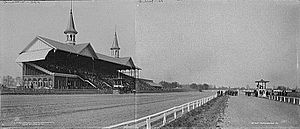
James Callahan and other business leaders started the Louisville, Harrods Creek and Westport Railway in 1870. Although it never went beyond Harrods Creek, its service helped the city's eastern suburbs grow, especially after the LRC bought and electrified the track in 1904.
The first Kentucky Derby was held on May 17, 1875, at the Louisville Jockey Club track (later called Churchill Downs). The Derby was started by Meriwether Lewis Clark, Jr., the grandson of William Clark of the Lewis and Clark Expedition, and grandnephew of the city's founder George Rogers Clark. Ten thousand people watched Aristides win the first race.
On February 2, 1876, professional baseball started the National League, and the Louisville Grays were one of the first teams. Although the Grays only played for two years, they began a long relationship between the city and baseball. In 1883, John "Bud" Hillerich made his first baseball bat from white ash wood in his father's shop. The first bat was for Pete "The Gladiator" Browning of the Louisville Eclipse (a minor league team). These bats became known as Louisville Slugger, and the company Hillerich & Bradsby quickly became one of the largest makers of baseball bats and other sports equipment in the world. Today, Hillerich & Bradsby makes over one million wooden bats each year.
In 1877, the Southern Baptist Theological Seminary moved to Louisville from South Carolina. Its new campus was supported by Louisville business leaders. It grew quickly, attracting students from all over the nation, and by the early 1900s, it was the second-largest accredited seminary in the United States. It moved to its current 100-acre (0.40 km2) campus in 1926.
In February 1882, Oscar Wilde gave a lecture in the city and met Emma Speed Keats, the niece of his favorite poet, John Keats.
On August 1, 1883, U.S. President Chester A. Arthur opened the first annual Southern Exposition. This was a series of World's Fairs that ran for five years near Central Park in what is now Old Louisville. A highlight was the largest display of incandescent light bulbs at the time, which had been recently invented by Thomas Edison, a former Louisville resident.
Downtown Louisville began to modernize in the 1890s. The Columbia Building, Louisville's second skyscraper, opened on January 1, 1890. The next year, famous landscape architect Frederick Law Olmsted was hired to design Louisville's park system, including Cherokee, Iroquois, and Shawnee Parks, connected by tree-lined parkways. Passenger train service arrived on September 7, 1891, with the completion of Union Station. Louisville's Union Station was then the largest train station in the South.
On March 27, 1890, a major tornado (an F4 on the Fujita scale) hit Louisville. The tornado destroyed 766 buildings and killed an estimated 74 to 120 people. At least 55 deaths happened when the Falls City Hall collapsed. This is one of the highest death tolls from a single building collapse due to a tornado in U.S. history.
In 1893, two Louisville sisters, Patty and Mildred J. Hill, who were schoolteachers, wrote the song "Good Morning to All" for their kindergarten class. The lyrics were later changed to the more famous "Happy Birthday to You", which is now the most performed song in English.
Also in 1893, the Louisville Presbyterian Seminary was founded. In 1963, it moved to a modern campus near Cherokee Park.
20th Century and Beyond
Early 20th Century
In the early 1900s, issues with political corruption became very clear in the 1905 Mayor election, which was called the most corrupt in the city's history. A group against corruption, called the Fusionists, briefly appeared. The results were later overturned. Elections slowly became less corrupt, but political groups still held power for decades.
The Waverly Hills Sanatorium opened in 1910 to treat tuberculosis patients. The hospital closed in 1961 and was later used as a retirement home. It was unused for over a decade until 1991, when it reopened for tours.
During World War I, Louisville became home to Camp Taylor. In 1917, the English horse "Omar Khayyam" became the first foreign-bred horse to win the Kentucky Derby. Two years later, in 1919, Sir Barton became the first horse to win the Triple Crown, though the term for the three races wasn't used for another 11 years.
In 1920, Louisville's first zoo was founded at Senning's Park. It barely survived the Great Depression and closed in 1939. The current Louisville Zoo did not open until 1969.
In 1923, the Brown Hotel's chef Fred K. Schmidt created the Hot Brown sandwich. It was an open-faced sandwich with turkey and bacon, covered in cheese and tomato. The Hot Brown became very popular and can still be ordered in many local restaurants today.
The Belle of Louisville, now the oldest river steamboat still operating, came to Louisville in 1931. That same year, the Louisville Municipal College for Negroes was created to allow black Louisvillians to attend classes. The college later joined the University of Louisville in 1951 when segregation ended.
On March 28, 1936, the river reached a high level, flooding parts of the city. In late January and February 1937, a month of heavy rain across the Ohio River Valley caused the "Great Flood of '37". The flood covered about 70 percent of the city and forced 175,000 residents to leave their homes. In Louisville, 90 people died. At its highest point on January 27, 1937, the waters were 30 feet (9.1 m) above flood level. Photojournalist Margaret Bourke-White took famous photos of the flood. Later, flood walls were built to prevent another such disaster.
Standiford Field was built in Louisville by the Army Corps of Engineers in 1941. Bowman Field, a smaller airport, had opened earlier in 1919.
Louisville was a center for factory war production during World War II. In May 1942, the U.S. government gave the Curtiss-Wright Aircraft Company a war plant at Louisville's air field to produce aircraft. The factory made the C-46 Commando cargo plane. In 1946, the factory was sold to International Harvester, which began making tractors and farm equipment. Otter Creek Park was given to Louisville by the U.S. Government in 1947, in thanks for the city's help during World War II.
Throughout the 1900s, the arts grew in Louisville. The Speed Art Museum opened in 1927 and is now Kentucky's oldest and largest art museum. The Louisville Orchestra was founded in 1937. In 1949, the Kentucky Shakespeare Festival began, and it is now the oldest free Shakespeare festival in the United States. The Kentucky Opera started in 1952, and the Louisville Ballet was founded that same year. In 1956, the Kentucky Derby Festival began to celebrate the annual Kentucky Derby. The next year, in 1957, the St. James Court Art Show started. Both are still popular festivals.
Mid-Century Decline
After prohibition ended, eight whiskey distilleries opened on 7th Street Road. Louisville tried to add them to the city to increase its tax income. The whiskey companies did not want to pay city taxes, so they convinced the Kentucky General Assembly to pass the Shively Bill. This bill made it much harder for Louisville to add new areas. The distilleries used Kentucky's laws to form a small city called Shively in 1938. Shively grew to include homes.
In 1946, a law was passed allowing a Metropolitan Sewer District to be formed. With sewer service expanding outside the city limits and laws preventing Louisville from adding new areas, places outside the city that grew after World War II became their own cities. This stopped Louisville from adding them. As a result, Louisville's population numbers stopped growing. The creation of these new communities helped defeat Louisville's attempt to join with Jefferson County in 1956. Louisville continued trying to add land.
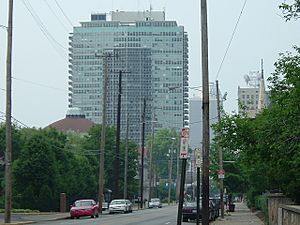
For various reasons, Louisville began to decline as an important city in the 1960s and 1970s. Highways built in the late 1950s made it easier for the growing middle class to move to new homes in the suburbs. With fewer people in the city, the downtown area began to struggle economically. Many popular buildings became empty. Even the strong Brown Hotel closed in 1971 (though it later reopened). Fontaine Ferry Park, Louisville's most popular amusement park in the early 1900s, closed in 1969 as people's entertainment tastes changed.
The once-strong farmer's market, Haymarket, closed in 1962 after 71 years. The final blow for the Haymarket, which was already declining, was the building of an Interstate 65 ramp through its main area. Highways not only made suburban living easier but also cut through older city neighborhoods, often dividing them permanently.
Another major tornado (an F4) hit on April 3, 1974, as part of the 1974 Super Outbreak of tornadoes that struck 13 states. It traveled 21 miles (34 km) and destroyed hundreds of homes in the Louisville area but caused only 2 deaths. It also heavily damaged Cherokee Park.
Despite these signs of decline, many things were happening that hinted at Louisville's comeback in the 1980s.
Southeast Christian Church, now one of the largest megachurches in the U.S., was founded in 1962 with only 53 members. In 1964, Actors Theatre of Louisville was founded. It was later named the "State Theater of Kentucky" in 1974.
In 1973, the racehorse Secretariat ran the fastest time ever in the Derby (at its current distance) at 1 minute 59⅖ seconds. The excitement around him increased interest in the Derby.
There were signs of revival in the 1970s. Throughout the decade, new buildings were constructed downtown, and many historic buildings were renovated. Louisville's public transportation, Transit Authority of River City, began operating a bus line in 1974. In 1981, the Falls of the Ohio was made a Federal conservation area.
On the negative side, in the early morning of February 13, 1981, sewer explosions happened in the southern part of Old Louisville and near the University of Louisville. The cause was traced to chemicals released into the sewer system from a nearby manufacturing plant.
Louisville continued to struggle in the 1980s as it tried to redevelop and grow. It tried to merge with the county government two more times in 1982 and 1983, but both attempts failed. Barry Bingham, Jr. sold the family business Standard Gravure in 1986.
Civil Rights Movement in Louisville
During the Civil Rights Movement in the late 1950s and 1960s, Louisville was affected because it still had a segregated society. Civil rights groups took many actions to challenge this. Also, black neighborhoods had declined during the city's economic downturn. Urban renewal efforts, meant to improve areas, had negatively affected the center of their neighborhoods.
After national civil rights laws passed in 1964 and 1965, African Americans continued to push for social changes. The National Association for the Advancement of Colored People (NAACP) had an office in the Parkland neighborhood, which had a majority African-American population. In Louisville, there was a political struggle between the NAACP and more active groups linked to Black Power. Their efforts to organize people helped cause a riot. Also, feelings were raw because Dr. Martin Luther King, Jr. had been killed less than two months before. On May 27, 1968, about 400 mostly African Americans gathered for a protest in Parkland. They were against the possible return of a white officer involved in an incident where physical conflict occurred during the arrest of two African-American men. The group was organized by the Black Unity League of Kentucky (BULK). BULK had announced that activist Stokely Carmichael would come to speak, but he had no such plans. When the crowd gathered, speakers spread rumors that Carmichael's plane had been purposely delayed. Protesters became angry, and a disturbance began.
The crowd threw bottles and started looting, forcing the police to retreat. By midnight, rioters had looted several stores in Downtown Louisville. Cars were overturned and some burned. Mayor Kenneth A. Schmied ordered 2,178 Kentucky National Guardsmen to help control the crowd. The mayor also set a citywide curfew. During the riots, 472 arrests were made, two African-American teenage boys were killed, and over $200,000 in property damage occurred. The National Guard stayed until June 4, 1968. After these events, the city's population changed a lot; the city became more racially separated by neighborhoods, and more middle-class people, both black and white, moved to newer homes in the suburbs.
Despite the Supreme Court's ruling in Brown v. Board of Education in 1954, Louisville's public schools were still mostly segregated, especially as neighborhoods became more separated due to economic changes. In 1971 and 1972, groups like the Kentucky Civil Liberties Union and the NAACP sued in federal court to desegregate the Louisville and Jefferson County school systems. The Kentucky Commission on Human Rights also sued, asking for desegregation through merging the Louisville, Jefferson County, and Anchorage school systems. By February 28, 1975, the state Board of Education ordered the merger of the Louisville and Jefferson County schools systems, effective April 1, 1975.
On July 17, 1975, Judge James F. Gordon ordered that a desegregation plan would start at the beginning of the 1975–76 school year, on September 4, 1975. The school system used mandatory busing to distribute students to integrate the newly merged school systems. Students were bused based on the first letter of their last name and their grade level. The busing aimed to achieve certain percentages of racial diversity in schools, no matter where students lived. In practice, the plan required black students to be bused for up to 10 of their 12 years in school, and white students for 2 of their 12 years. In 1978, the judge ended his supervision, but the order remained in effect in some places. The school system continued the busing system. In the mid-1980s, the school system changed the plan to try to provide more local schooling for students. Guidelines for student population percentages based on ethnicity remained.
Revitalization Efforts
From the 1980s until today, Louisville has grown in popularity and success. This can be seen in many changes during this time, including a lot of new buildings and improvements downtown.
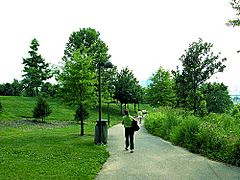
Many cultural attractions were started or expanded during this period. The Kentucky Center for the Arts officially opened in 1983. In 1984, the center hosted one of the U.S. presidential election debates between Ronald Reagan and Walter Mondale. Today, the Center hosts many touring plays and performances by the Kentucky Opera and the Louisville Ballet. An IMAX theater was added to the Kentucky Science Center in 1988. Phase I of the Louisville Waterfront Park was finished in 1999, and Phase II was completed in 2004. The Kentucky Theater, originally a movie theater built in 1921, reopened in 2000 as a performing arts venue.
In 1988, the Louisville Falls Fountain, the tallest computerized fountain in the world, began operating on the Ohio River at Louisville. Its 420-foot (130 m) high spray (later reduced to 375 feet (114 m) due to energy costs) and fleur-de-lis patterns decorated Louisville's waterfront until the fountain was shut down in 1998. For ten years, Louisville had this unique landmark.
In communications, The Courier-Journal, Louisville's main local newspaper, was bought by the media company Gannett in 1987. The Louisville Eccentric Observer (LEO), a popular alternative newspaper, was founded in 1990. Velocity was later released by the Courier-Journal to compete with the LEO in 2003.
In 2003, the city of Louisville and Jefferson County merged into a single government called Louisville-Jefferson County Metro Government. This merger made Louisville one of the most populated cities in the U.S. The change allowed some services and activities to be combined, providing better government for the region.
New changes and growth continued in the city. The entertainment and retail area called Fourth Street Live! opened in 2004, and the Muhammad Ali Center opened in 2005. Between the 1990 Census and 2000 Census, Louisville's metro area population grew more than Lexington's and Cincinnati's.
Preserving Louisville's History
Since 1884, The Filson Historical Society (originally called the Filson Club), with its large collections, has led the way in preserving Louisville's history. The University of Louisville and the Louisville Free Public Library also have many historical collections.
As of 2016, Louisville does not have a museum focused only on the city's history. However, various museums and historic homes have displays about this history. These include the Filson, Portland Museum, Historic Locust Grove, the Falls of the Ohio State Park interpretive center (Clarksville, Indiana), Howard Steamboat Museum (Jeffersonville, Indiana), Carnegie Center for Art & History (New Albany, Indiana), and the Thomas D. Clark Center for Kentucky History (Frankfort).


